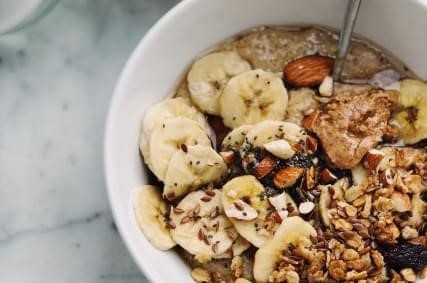Fibre – Are You Getting Enough?
Good health stems from good dietary habits. Read how fibre can benefit your health in many ways.
Most of us need to eat more fibre in our diets. Eating plenty of fibre is associated with lower risks of serious conditions such as heart disease, stroke, type II diabetes and bowel cancer 1. But what about the other more common effects of a low fibre diet?
Fibre is most commonly associated with constipation. It may not be nice to talk about. So many people may ignore the problem, but it can cause discomfort and may lead to painful piles. A regular bowel habit can also help to eliminate toxins and unwanted hormones from the body, so is an important part of good health and wellbeing.
As human beings evolved, much of their diet was rich in fibre. Despite an image of cavemen solely eating a meat diet, meat was in fact scarce and difficult to capture. So a large part of the diet consisted of tubers, roots, vegetables and seeds. Until recent times, foods would have been eaten more often in their natural state, with skins on fruit and vegetables, and eating whole grains rather than the refined white ones we know today. Westernised eating habits have stripped a lot of fibre from the diet. People now prefer the convenience of ready meals and pre-prepared foods which are often lower in fibre.
How much fibre is there in an average serving of… 2-3
- Bran flakes: 6 grams
- Porridge oats: 5 grams
- Black beans: 15 grams
- Avocadoes: 4 grams
- Raspberries: 7 grams
- Almonds: 3 grams
- Peas: 7 grams
- Pumpkin seeds: 2 grams
Simple steps to increase fibre in your diet
Government guidelines recommend 30 grams of fibre per day, but most people in the UK only get around half of that 1. While we are constantly being reminded about over-eating, it seems strange we just don’t get enough of this vital food source 4. Making some straightforward changes to your diet will bring benefits for your overall health, and help to avoid problems in the future.
First, look at your daily food intake. Keep a diary to record what you eat. Could you replace white bread, cereals and pasta with whole grain varieties? There are so many alternatives on the market, you could be spoilt for choice.
Second, and perhaps most importantly for a rich source of vitamins and minerals, increase your vegetable and fruit intake. Get into a habit of having vegetables or fruit with every meal.
Third, turn towards pulses such as beans, peas and lentils as part of your daily diet. We rely so much on potatoes and rice as fillers. Why not consider a lentil dahl or chick pea curry? Or add black beans into a chilli meal?
Here are a few more suggestions of ways to boost your fibre intake
- Add 2 tablespoons of black beans to soups or stews (7 grams)
- Replace a chicken curry with a chick pea one (13 grams)
- Serve a lentil dahl as a side dish (10 grams)
- Have wholemeal toast with peanut butter instead of marmalade (5 grams)
- Have half an avocado as a starter to your meal (4 grams)
- Put raspberries, blueberries and/or banana on porridge (5 grams)
- Stir a tablespoon of ground flax seeds into porridge (2 grams)
- Sprinkle pumpkin seeds onto salads (2 grams)
- Have unpeeled fruit for dessert (4 grams)
- Go nuts! Enjoy munching on a small handful of nuts (3 grams)
It is important when changing your daily fibre intake to do so slowly at first, otherwise it may cause bloating and discomfort. Start with one suggestion at a time, and gradually build up. Finally, if you are experiencing problems with chronic constipation or other health issues, seek advice from your GP or nutritionist. Don’t sit on it!
Remember, you can visit our blog to discover recipes and how you can cook for one.
References:
1. NHS: How to get more fibre into your diet. Available at: https://www.nhs.uk/live-well/eat-well/how-to-get-more-fibre-into-your-diet/. Accessed 9 May 2019.
2. Nutronix 2019: Available at: https://www.nutritionix.com/food/avocado/100-g Accessed 10 May 2019
3. Mayo Clinic 2019: USDA National Nutrient Data base. Available at: https://www.mayoclinic.org/healthy-lifestyle/nutrition-and-healthy-eating/in-depth/high-fiber-foods/art-20050948. Accessed 11 May 2019.
4. EuroMonitor International 2019: Available at: https://blog.euromonitor.com/nutrition-2017-fibre/ Accessed 11 May 2019.









